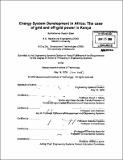| dc.contributor.advisor | David H. Marks. | en_US |
| dc.contributor.author | Steel, Katherine Deaton | en_US |
| dc.contributor.other | Massachusetts Institute of Technology. Engineering Systems Division. | en_US |
| dc.date.accessioned | 2008-12-11T18:36:42Z | |
| dc.date.available | 2008-12-11T18:36:42Z | |
| dc.date.copyright | 2008 | en_US |
| dc.date.issued | 2008 | en_US |
| dc.identifier.uri | http://hdl.handle.net/1721.1/43840 | |
| dc.description | Thesis (Ph. D.)--Massachusetts Institute of Technology, Engineering Systems Division, 2008. | en_US |
| dc.description | Includes bibliographical references. | en_US |
| dc.description.abstract | This research used a combination of a grounded theory approach and system dynamics to study the electric power system in Kenya and to model the feedback at work in the development of the system. The ethnographic study revealed the challenges faced by consumers in choosing between grid and off-grid power options. Examination of this challenge leads to the hypothesis that competition between the grid and off-grid markets is contributing to the low growth in power consumption and that there is the potential for off-grid to become the dominant option in the future. This theory guided the construction of a system dynamics model focusing on consumers' decision-making and their interaction with the operation of the system. I then used the model to explore the dynamics of the system through scenario testing. There were two key outcomes from the model. The first showed that given the parameters chosen in most cases there is a clearly dominant option, although it changes over time. This finding points to the second key outcome the model, which is that there are realistic scenarios under which off-grid generation will become the dominant supply source. This shift could be induced by either reduced overhead on photovoltaic panels or high fuel prices. The outcomes from this research have implications for future electricity planning in Kenya and elsewhere in Africa. In particular, there is a need to decouple the system from external prices or account for the extreme uncertainty in fuel prices. Given the potential shift to large-scale off grid power generation, energy planners also need to look at options for managing a decentralized power system architecture and consider how to build in options for future reintegration if a large-scale centralized generation source comes online. | en_US |
| dc.description.abstract | (cont.) This research has both academic and applied contributions. On the academic side, it extends the range of engineering systems modeling to include qualitative factors found in an African environment. These factors include the addition of reliability and availability of the electric power grid and the biases in decision-making, which differ from those in industrialized countries. While the model clearly has direct application in Kenya, it was designed with flexibility to be expanded to include other countries and regions and could be a useful tool for understanding policy trade-offs in African electrification planning. | en_US |
| dc.description.statementofresponsibility | by Katherine Deaton Steel. | en_US |
| dc.format.extent | 271 p. | en_US |
| dc.language.iso | eng | en_US |
| dc.publisher | Massachusetts Institute of Technology | en_US |
| dc.rights | M.I.T. theses are protected by
copyright. They may be viewed from this source for any purpose, but
reproduction or distribution in any format is prohibited without written
permission. See provided URL for inquiries about permission. | en_US |
| dc.rights.uri | http://dspace.mit.edu/handle/1721.1/7582 | en_US |
| dc.subject | Engineering Systems Division. | en_US |
| dc.title | Energy system development in Africa : the case of grid and off-grid power in Kenya | en_US |
| dc.type | Thesis | en_US |
| dc.description.degree | Ph.D. | en_US |
| dc.contributor.department | Massachusetts Institute of Technology. Engineering Systems Division | |
| dc.identifier.oclc | 262700053 | en_US |
